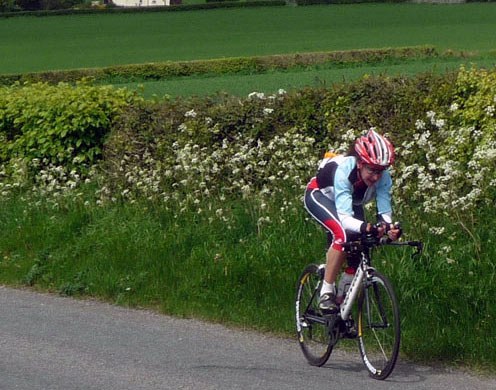Threshold training involves riding at an intensity which can be maintained for an hour without creating excess burning in your legs (lactic acid creation). Your threshold is the level which makes full use of your aerobic capacity (oxygen) but doesn’t tip over into anaerobic exercise (which creates lactic acid).
Threshold training essentially involves a level which might be described as ‘comfortably hard’. It is not race pace, but it requires focus and determination to keep at that threshold level. If you go slightly harder than your threshold level you will fatigue much more quickly.
Your threshold level will be important for any endurance event. Increasing your threshold capacity enables improved performance for distance events.
Other Terms for Threshold Training
Note: There are quite a few terms relating to threshold training. They can mean slightly different things. Also, I wouldn’t get too concerned about being at exactly ‘right’ level, in practise there is no clear line. Some other terms:
- Anaerobic Threshold (AT) The maximum level before you start using anaerobic parts of energy creation. Also referred to as blood lactate accumulation (OBLA)
- Lactate Threshold - the maximum level before you start creating lactic acid faster than you can remove it. Same principle as Anaerobic threshold.
- Functional Threshold Power (FTP)- the maximum power you could sustain for an hour.
Relation to VO2 Max
Heart Rate Zone for Threshold Training.
- For cyclists, threshold training may be between 85% – 90% of max heart rate.
- For runners, threshold training tends to be higher 90-93% of max heart rate.
Threshold Sessions
You could do threshold sessions for 30 minutes, 1 hour or longer in a continuous training zone. Alternatively you could split them up into ‘intervals’ of 20 minutes or if you like variety, 4*10 minute or other combination.
Personally, I prefer to do in continuous sessions, I don’t feel need to split up into intervals.
I’ve found over the years that with improved general fitness and a bigger accumulation of miles a greater ability to train at this threshold level. Everyone will have a different capacity, but to start off with 10% of your training at threshold level is good.
Just Below Threshold
Riding at the upper end of your aerobic capacity is also a good training session. For example, at 80% of your heart rate.
Increasing Threshold Power
Before, working on threshold power, it is good to have a reasonable base of cycling in the legs. You need to be comfortable with the distance before moving onto harder session.
During November and December, I have not done any intervals, and most riding is at a steady or moderate intensity. In the early season (January onwards), I like doing threshold sessions because it is a good way to get back into the grove of riding at higher intensity. In January, I start adding some threshold sessions in, to acclimatise body for early season races and later harder efforts.
- I will do one or two sessions per week, with a duration of 20 mins to 1 hour. As the year progresses, I will increase time and frequency of these threshold power sessions.
- When doing these threshold sessions, I am fully concentrated on the training. I concentrate on a breathing exercise and am concentrating on every aspect of cycling – such as maintaining a smooth cadence. It requires a persistent effort to keep at this intensity.
- I like to choose a flat smooth road, I also like having a tailwind, this gets you used to riding at 25mph + which is good for later time trials. (plus it feels great to be riding at that speed after plodding around at 16mph all winter)
- After a threshold sessions I will have a rest day or recovery ride.
The advantage of threshold training is that:
- It’s a very nice tempo to be training at. It feels fast, but it doesn’t completely knock you out.
- You definitely will get a buzz from training at this level, you feel all the right chemicals released from exercise, but not as painful as higher end sessions.
Increasing Threshold Power Through Harder Intervals
High intensity interval sessions (close to VO2 max), are intervals above your anaerobic threshold. Here you are riding at above the pace of a 10 mile time trial. You are definitely using anaerobic capacity, and you will feel the accumulation of lactic acid. However, by training at above your threshold power in a higher hear rate, you will also see an increase in your threshold power.
Research suggest high intensity intervals are an excellent way of also increasing aerobic capacity.
- High Intensity intervals (90-95% HR max) increase VO2 Max more than threshold training (link) Intervals and Threshold power (link pdf)
For well trained athletes, it’s even more important to use higher end intervals to increase aerobic capacity. However, these higher end intervals are harder are place more stress on the body. Therefore, these threshold sessions definitely have their place in improving overall fitness.
Related


Heart rate values are given against max heart rate. How do these translate if you take the gap between max and min?